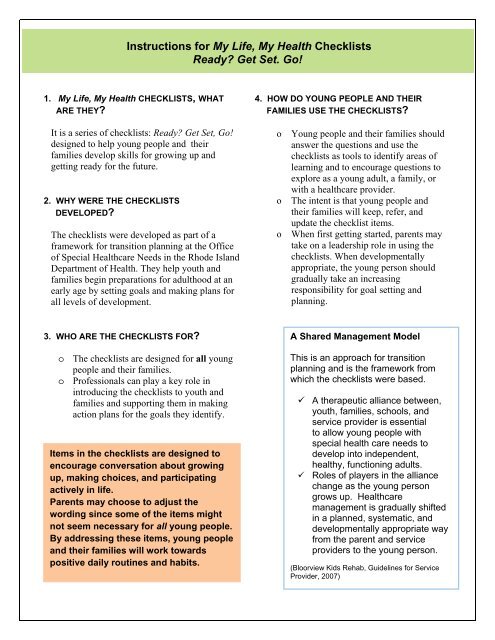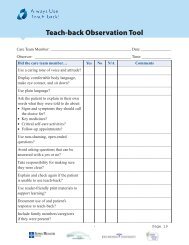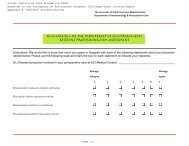Instructions for My Life, My Health Checklists Ready? Get Set. Go!
Instructions for My Life, My Health Checklists Ready? Get Set. Go!
Instructions for My Life, My Health Checklists Ready? Get Set. Go!
Create successful ePaper yourself
Turn your PDF publications into a flip-book with our unique Google optimized e-Paper software.
<strong>Instructions</strong> <strong>for</strong> <strong>My</strong> <strong>Life</strong>, <strong>My</strong> <strong>Health</strong> <strong>Checklists</strong><br />
<strong>Ready</strong> <strong>Get</strong> <strong>Set</strong>. <strong>Go</strong>!<br />
1. <strong>My</strong> <strong>Life</strong>, <strong>My</strong> <strong>Health</strong> CHECKLISTS, WHAT<br />
ARE THEY<br />
4. HOW DO YOUNG PEOPLE AND THEIR<br />
FAMILIES USE THE CHECKLISTS<br />
It is a series of checklists: <strong>Ready</strong> <strong>Get</strong> <strong>Set</strong>, <strong>Go</strong>!<br />
designed to help young people and their<br />
families develop skills <strong>for</strong> growing up and<br />
getting ready <strong>for</strong> the future.<br />
2. WHY WERE THE CHECKLISTS<br />
DEVELOPED<br />
The checklists were developed as part of a<br />
framework <strong>for</strong> transition planning at the Office<br />
of Special <strong>Health</strong>care Needs in the Rhode Island<br />
Department of <strong>Health</strong>. They help youth and<br />
families begin preparations <strong>for</strong> adulthood at an<br />
early age by setting goals and making plans <strong>for</strong><br />
all levels of development.<br />
o<br />
o<br />
o<br />
Young people and their families should<br />
answer the questions and use the<br />
checklists as tools to identify areas of<br />
learning and to encourage questions to<br />
explore as a young adult, a family, or<br />
with a healthcare provider.<br />
The intent is that young people and<br />
their families will keep, refer, and<br />
update the checklist items.<br />
When first getting started, parents may<br />
take on a leadership role in using the<br />
checklists. When developmentally<br />
appropriate, the young person should<br />
gradually take an increasing<br />
responsibility <strong>for</strong> goal setting and<br />
planning.<br />
3. WHO ARE THE CHECKLISTS FOR<br />
o The checklists are designed <strong>for</strong> all young<br />
people and their families.<br />
o Professionals can play a key role in<br />
introducing the checklists to youth and<br />
families and supporting them in making<br />
action plans <strong>for</strong> the goals they identify.<br />
Items in the checklists are designed to<br />
encourage conversation about growing<br />
up, making choices, and participating<br />
actively in life.<br />
Parents may choose to adjust the<br />
wording since some of the items might<br />
not seem necessary <strong>for</strong> all young people.<br />
By addressing these items, young people<br />
and their families will work towards<br />
positive daily routines and habits.<br />
A Shared Management Model<br />
This is an approach <strong>for</strong> transition<br />
planning and is the framework from<br />
which the checklists were based.<br />
A therapeutic alliance between,<br />
youth, families, schools, and<br />
service provider is essential<br />
to allow young people with<br />
special health care needs to<br />
develop into independent,<br />
healthy, functioning adults.<br />
Roles of players in the alliance<br />
change as the young person<br />
grows up. <strong>Health</strong>care<br />
management is gradually shifted<br />
in a planned, systematic, and<br />
developmentally appropriate way<br />
from the parent and service<br />
providers to the young person.<br />
(Bloorview Kids Rehab, Guidelines <strong>for</strong> Service<br />
Provider, 2007)
5. SERVICE PROVIDERS CAN:<br />
o<br />
o<br />
o<br />
Encourage youth and families to use the<br />
checklists to set goals and make plans <strong>for</strong><br />
developing skills <strong>for</strong> growing up.<br />
Assist families in making action plans to<br />
meet their identified goals: suggest<br />
workshops, services, resources, or<br />
strategies that may encourage and<br />
help them.<br />
Raise developmentally appropriate life<br />
skills in goal discussions if young people<br />
and families do not.<br />
o Incorporate life skills goals in service<br />
plans, 504, Individualized Education Plan<br />
(IEP) & Individualized Learning<br />
Plan (ILP)<br />
o<br />
o<br />
Ask what goals they are currently<br />
working on.<br />
Reflect on how you can incorporate the<br />
shared management model into your work.<br />
6. WHICH CHECKLISTS SHOULD THE YOUNG<br />
PERSON AND FAMILY USE<br />
o The checklists include a developmental<br />
progression of skills.<br />
o The young person and family move from<br />
one checklist to another based on their<br />
level of preparation <strong>for</strong> adulthood. For<br />
example, an 11 year-old may be using<br />
<strong>Ready</strong> and another may be using <strong>Get</strong> <strong>Set</strong>.<br />
o More than one may be used at a time.<br />
7. ARE THERE SPECIFIC AGE RANGES FOR<br />
THESE CHECKLISTS<br />
Generally speaking, the checklists may be<br />
appropriate <strong>for</strong> the following age ranges:<br />
<strong>Ready</strong> ages 7-12<br />
<strong>Get</strong> <strong>Set</strong> ages 13-16<br />
<strong>Go</strong>! ages 17 and older<br />
Every young person will move through the<br />
checklists at his or her own pace. As you review<br />
goals and progress with the young person and<br />
their families, discuss with them how they feel<br />
and ask them if they are ready <strong>for</strong> the next<br />
checklist in the series.<br />
8. TIPS FOR SERVICE PROVIDERS HELPING<br />
A YOUNG PERSON TRANSITION<br />
TO ADULTHOOD:<br />
<br />
<br />
<br />
<strong>Ready</strong> is <strong>for</strong> youth and families just<br />
starting to think about growing up and is to<br />
be used as early as possible.<br />
As early as age 7, young people<br />
can think about the statement,<br />
“I ask at least one question during a<br />
healthcare visit”.<br />
<strong>Get</strong> <strong>Set</strong> is <strong>for</strong> those who have taken some<br />
steps in planning <strong>for</strong> the future and focus<br />
on next steps.<br />
Young people can work on<br />
“I ask my doctor questions during<br />
healthcare visits”.<br />
<strong>Go</strong>! is <strong>for</strong> those nearly ready to transition<br />
into adult services.<br />
Young people address<br />
“ I ask most questions during a<br />
healthcare visit”.<br />
Speak directly to the young person<br />
whenever possible. When appropriate,<br />
suggest meeting alone with the young<br />
person <strong>for</strong> a portion of the time.<br />
Direct questions to the young person:<br />
Ask the young person if they have any<br />
questions.<br />
Provide choice and discuss options with<br />
the young person and request their input.<br />
Office of Special <strong>Health</strong>care Needs<br />
For more in<strong>for</strong>mation, call the<br />
HEALTH In<strong>for</strong>mation Line<br />
1.401.222.5960<br />
Adapted from Bloorview Kids Rehab, Guidelines <strong>for</strong> Service Provider, 2007





